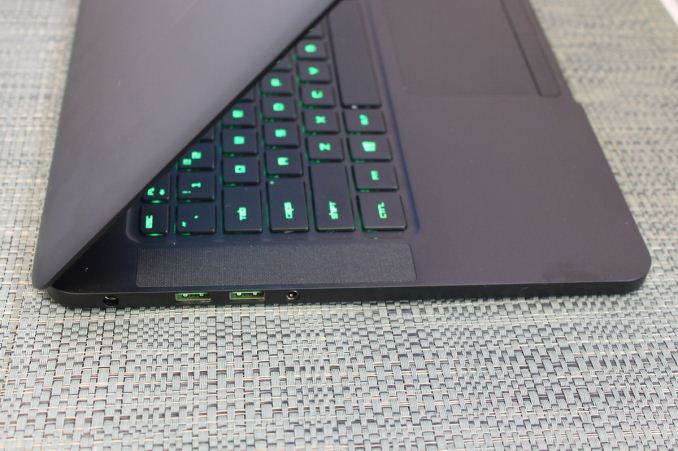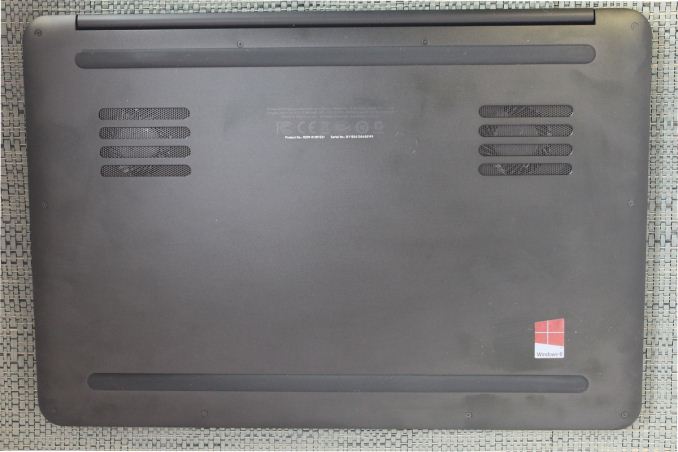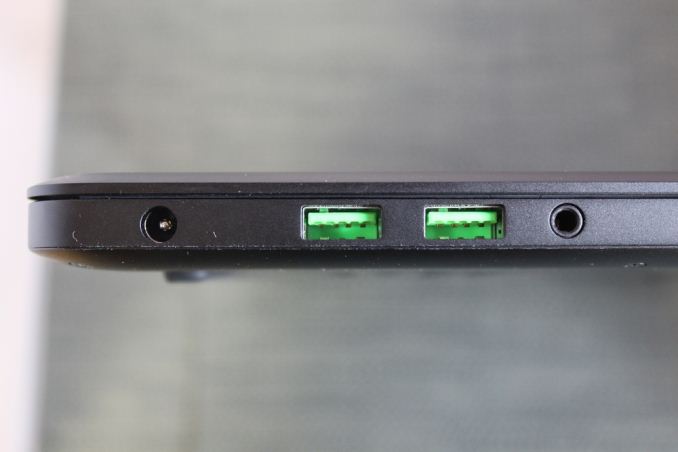The 2015 Razer Blade Review
by Brett Howse on February 11, 2015 2:00 PM EST- Posted in
- Laptops
- Razer
- Razer Blade
- Notebooks
- GTX970M
Design and Chassis
Internally, Razer outfitted the new Blade with a new CPU, GPU, and more system memory. But the chassis of the 2015 Blade has not changed at all. That is not really a bad thing though, since the Razer Blade already carried with it a fantastic CNC aluminum body. Comparisons are often made with the Retina MacBook Pro, and for good reason. Both are solid computers made of nicely crafted aluminum, and the overall dimensions of the Razer Blade are very similar to the 15 inch Retina MacBook Pro.
Also identical to the 2014 Blade is the matte black finish of the anodized aluminum, which feels great and resists fingerprints. The accents are all in “Razer Green” which is consistent across their product line. The USB accents, the keyboard backlighting, the power LED, and the Razer symbol on the back of the LCD are all represented in this shade.
The body of the Razer Blade is very strong, with no flexing or creaking to be had. The top of the lid keeps the two ridges running down the length of the display, which give a nice effect and likely increase rigidity.
The cooling system is also similar. Underneath the Razer Blade, there are two air intakes, which cool the CPU and GPU and push the heated air out into a vent between the display and the back of the laptop. This keeps the vent hidden from view, and makes for a great looking laptop, although the hot air can heat up the top part of the keyboard when the laptop is being worked hard.
We will see how well the cooling system handles the changes later in the review. It now has an additional ten watts of power to dissipate from the new CPU, and an even more powerful GPU, albeit one that is more power efficient as well.
The keyboard is also unchanged, and while it is a great keyboard, with good key travel, and nice feel, this is one area where Razer may have a chance to allow more customization. The “Razer Green” is adjustable as far as intensity, but it would be great to allow more user customization like the Razer Chroma keyboard, or at least color adjustability by the end user.
The trackpad on the Razer Blade is very large, and incredibly smooth. This is not a clickpad, and keeps the dedicated left and right click buttons under the trackpad. This is a layout that I prefer, but this is a preference and others may prefer the added real estate that a clickpad affords them. Regardless, it is a great trackpad. The smooth surface is very easy to move around on, and there were no issues that I found with two finger scrolling or other gestures.
Beside the keyboard is the front facing stereo speakers, and the sides of the device carry the three USB 3.0 ports, the 3.5 mm headset jack, HDMI 1.4 port, and the Kensington lock. An SD card slot would be nice, but is still lacking on the 2015 model. Those hoping for HDMI 2.0 are out of luck. In order to enable NVIDIA Optimus graphics switching, the output actually comes from the integrated GPU. Since Haswell only supports HDMI 1.4, the Razer Blade outputs on the HDMI 1.4b spec which limits the output to 3840x2160 at 30 Hz. Razer has told me that their data shows that more people prefer HDMI at this time, so they are sticking with this over DisplayPort for the external monitor connection.
Razer latops continue the elegant look of the black anodized aluminum, with no garish extras. Though it would be nice to allow for more user customization, it is difficult to fault Razer when they have been so consistent in their styling. The green perfectly matches their other products such as mice and headsets. Though they made no changes to the design of the laptop for 2015, there was little need to, since it was already very high quality, and with great components.















116 Comments
View All Comments
fokka - Wednesday, February 11, 2015 - link
i don't think the GPU is swappable on a slim machine like this. afaik, MXM is mostly used in configurable machines like clevo and similar brands.JoshHo - Wednesday, February 11, 2015 - link
The module is integrated into the board and cannot be upgraded or replaced.forwardbias - Wednesday, February 11, 2015 - link
Is the temperature test underload? What about normal usage? Idle?Oxford_Guy - Thursday, February 12, 2015 - link
Under torture-test load, from the sound of itboeush - Thursday, February 12, 2015 - link
Personally, I don't get the attraction of cramped little keyboard, cramped little screen, too much heat and noise, and not enough battery for way too much money.Maybe if Razor, in their infinite wisdom, deigned to build a 17" model with a full size keyboard and a 980m ... then I'd be willing to consider it.
Oxford_Guy - Thursday, February 12, 2015 - link
I have a 13" Macbook Air currently, which is even smaller, and don't find the keyboard cramped at all - I think that's a non-issue unless you have huge hands. Also a 14" screen actually offers a reasonable amount of screen real estate for a portable machine. Those 15.6" laptops with numpad keyboards really aren't that portable, which is the point of a notebook!Battery life is even decent in this for a gaming laptop.
Heat and noise *are* still concerns, however...
sviola - Thursday, February 12, 2015 - link
Razer does have a 17" laptop. It's called the Razer Blade Prohfm - Saturday, February 21, 2015 - link
The keyboard on the Blade is awesome. Not cramped. My guess by your comment is that you're just not the target for their systems. I love it.gtrenchev - Thursday, February 12, 2015 - link
If it wasn't for the stupid logo :)Seriously Razer, it's just childish and tasteless. The only detail that repels me.
Oxford_Guy - Thursday, February 12, 2015 - link
It's not as bad as Alienware and MSI's gaming machines...